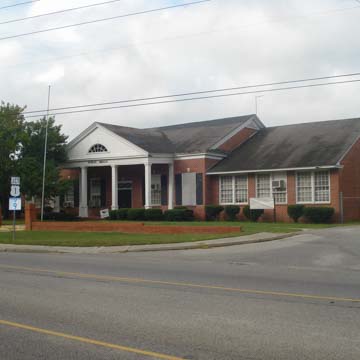Robert Smalls Elementary School in Cheraw was completed in 1953 for the town’s African American students. It was an example of South Carolina’s effort, through what was then known as an equalization program, to create “separate but equal” schools for black students in the 1950s. The Colonial Revival architecture of Robert Smalls was influenced by Cheraw’s early historic preservation movement.
The original Robert Smalls Elementary School was a two-story brick structure built in 1920. In this building, twelve teachers educated first through sixth graders until a state-sponsored survey in 1949 found the school to be overcrowded. Along with ten other elementary schools in Chesterfield County, the state determined that the buildings be replaced and the African American students consolidated into larger schools. The money for this effort came in 1951, when South Carolina responded to a school desegregation lawsuit out of Clarendon County by creating a statewide school improvement program aimed primarily at building new public schools for African American students. The state wanted to prove to the federal courts that it was committed to making the idea of separate but equal schools a reality. It therefore implemented a three percent sales tax to fund new school construction and used the revenue overwhelmingly to construct or improve black schools.
Robert Smalls Elementary School was an early recipient of building funds raised through the new tax. Designed to accommodate one thousand students, it was located on Cheraw’s Front Street, near the center of town in an African American neighborhood. The building was constructed of locally made brick from the Palmetto Brick Company. While most mid-century equalization schools are modernist in style, Robert Smalls is a Colonial Revival school with an entry portico, multi-paned windows in wood frames, and a gabled roof. The school contained eight classrooms, administrative offices, and indoor plumbing.
Cheraw, Incorporated, an organization created by city leaders to help preserve local historic buildings and ensure that new buildings fit the historic character and design of old Cheraw, influenced the design of Robert Smalls Elementary School. Cheraw was a regional market town for surrounding tobacco and rice farmers. It was settled in the 1760s and incorporated in 1820. By the mid-twentieth century, its townscape still retained many of the buildings and much of the character from its antebellum boom years. In the postwar years, city leaders saw the benefits of maintaining the historic character of Cheraw as a means to attract industry and other economic development. Cheraw, Incorporated, became an instrument for reaching that goal, and hired the Florence-based architectural firm Hopkins, Baker and Gill to design a Colonial Revival building for Robert Smalls Elementary.
Students attended classes in Robert Smalls Elementary until the 1990s, when it was replaced by a newer building. The former school is currently owned by a non-profit that assists youth in the community.
References
Crow, E. R. “South Carolina’s School Building Program.” American School and University25 (1953–1954): 161-164.
Dobrasko, Rebekah. “Upholding ‘Separate but Equal’: South Carolina’s School Equalization Program, 1951-1955.” Master’s thesis, University of South Carolina, 2005.
“Robert Smalls School, Cheraw, South Carolina.” South Carolina Picture Project. Accessed October 9, 2015. www.sciway.net.
Workman, W. D., Jr. “Operation ‘Equalize’: South Carolina Re-works Her Schools.” South Carolina Magazine17 (October 1953): 6-13.














